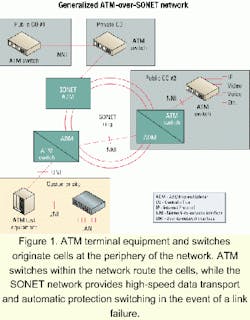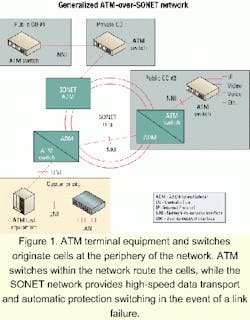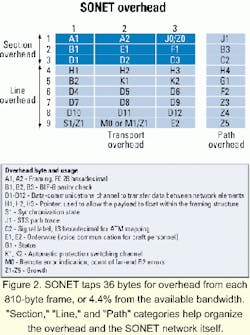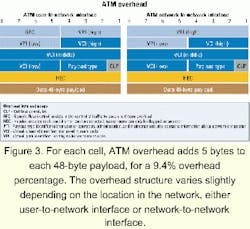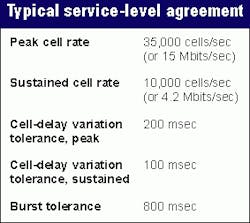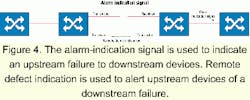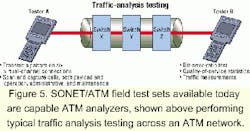Handheld SONET test sets tackle ATM
With ATM over SONET a prevalent architecture today, field technicians are demanding more than ever from their field test sets.
FRED KING, Sunrise Telecom
ATM and SONET are married in today's network. While a clouded future for both SONET and ATM have been widely reported, equipment investments in these established technologies are expected to continue to grow at 20% annually well into the 2000s, according to Pioneer Consulting. With so much investment-both past and future-going into SONET and ATM, the standard SONET field test set is now pressed into service to go beyond the physical layer to extend up into the ATM layer. Field technicians are demanding more from their field test sets and test equipment suppliers are responding.
Successful ATM-over-SONET network deployment and maintenance hinges on having the right knowledge and right analysis tools. Since ATM and SONET are closely linked, the chosen test set should cover both SONET and ATM. Looking solely at one or the other will only provide part of the answer to any given problem. It is not uncommon for ATM network problems to be traced to faults in the underlying SONET network. Unless the SONET network can be tested and verified, it is difficult to determine where the fault lies. The same goes for ATM, which can exhibit a host of problems even though the underlying physical layer may be error-free.Much has been written about provisioning and maintaining ATM networks. Those discussions often concentrate on the ATM layer. The physical layer is ignored on the assumption that it is working flawlessly. If not, it is assumed, again falsely, that a simple bit-error-ratio test (BERT) will ferret out any problems. Let's explore various ways of detecting and isolating typical problems at the interface between ATM and SONET.
In a typical SONET/ATM network (see Figure 1), a SONET ring transports ATM cells. The cells originate at the periphery of the network and are routed through the network based on predefined virtual connections. Between the ATM switches, each channel or data flow is assigned a unique virtual-channel connection (VCC). The benefit of this arrangement is that the SONET ring provides 50-msec automatic protection switching (APS) in the event of a failure, while ATM provides network flexibility and a mechanism to provision and manage traffic.
On the downside, both ATM and SONET require overhead that cuts into the bandwidth available to the end user (see Figures 2 and 3). The price of the overhead is money well spent, since the overhead contains valuable diagnostic information.Today's network professional is often mobile, traveling by automobile or even airplane from site to site. It is simply not practical to carry several individual AC-powered test instruments. The economics of arming each field technician with an effective test suite also points toward a single combined SONET/ATM test set.
If a technician is unable to detect ATM cells in the SONET payload, the first thing to check is whether the SONET network is configured for ATM. The signal label overhead byte (C2) should be set to 13 hexadecimal. Also check that the signal label is not set for another payload assignment, such as virtual tributary, which is 02 or 03 hexadecimal. If a payload label mismatch alarm is also being received, then the search should be narrowed to payload types and a close look at the SONET C2 overhead byte is warranted. When the payload assignment is misconfigured, the ATM cells will not begin at the proper location within the SONET payload structure-a condition called "loss-of-cell delineation."It is not uncommon for a SONET network today to carry both legacy time-division multiplexing (TDM) traffic and ATM cells in the same fiber. Also called "hybrid transport," this approach is an outgrowth of a network in transition. For the ATM traffic, the cells originate in an ATM switch. The ATM data may then find itself sharing an existing high-speed link with voice TDM traffic. That presents a problem if either the ATM or TDM traffic needs to be tested at any point along the shared portion of the network. Any test equipment must be capable of internally demultiplexing the high-speed data and performing ATM analysis on the subsequent lower-rate signal.
The mixed ATM and TDM traffic scenario may require that several very different tests be conducted at the same circuit access location. The tests may include ATM traffic analysis, dual tone multifrequency dialing analysis, SONET overhead analysis, alarm monitoring, and even Integrated Services Digital Network protocol analysis. All are possible from today's single-unit field test sets.
Since one of the main benefits SONET provides is APS, the relationship between APS and ATM deserves some discussion. For most APS implementations, a "working" fiber is backed up with a second "protection" fiber. SONET specifications GR-253-CORE and G.841 state that SONET network elements (NEs) are required to detect a network fault within 10 msec. The NEs on either side of the failed link are then required to complete a switchover to the "protection" fiber within 50 msec.
During the detection and switchover times, ATM cell data traversing the network inevitably will be lost. The number of cells depends on the time it takes to complete the switchover and the network data rate. At OC-12 (622 Mbits/sec) rates, about 70,000 cells could be lost in 50 msec. (OC-12 data rate x SONET payload ratio x switchover time / ATM bits per cell = 622 Mbits/sec x (86/90) x 50 msec / (53x8) = 70,000 ATM cells in 50 msec at OC-12 rate.) The number of cells lost to any particular ATM VCC cannot be determined, but it is fair to say that an APS switchover will have an adverse effect on the ATM network layer. (How ever, a 50-msec disruption is better than a more permanent failure, as would occur if the network were not protected.)
Let's explore a hypothetical case of what can go wrong with APS. Sup pose that several times an hour the ATM network loses all cells for short periods of time lasting tens of milliseconds. Just before the periods of cell loss, a high rate of ATM header error-control errors is detected. Other wise, the network is fine, and ATM HEC errors are not abnormally high between the periods of cell loss. During the periods of cell loss, ATM operation, administration, and maintenance (OA&M) cells are received, indicating a network failure. (OA&M cells are specialized cells that carry information about the ATM network health.) Examination of the SONET network administrative system reveals that one of the add/drop multiplexers is initiating APSs several times an hour. The APSs are most likely causing the loss of cells, but it's harder to determine what is initiating the APSs in the first place.
Troubleshooting in the field begins by using the SONET/ATM field test set to confirm the APSs. By monitoring two SONET overhead bytes called K1 and K2, the test set waits for, then measures the amount of time for the network to complete a switchover, specified to be within 50 msec. The same test set can also confirm the ATM HEC errors and other ATM network statistics such as cell-error ratio. OA&M cells can also be captured and decoded.
Digging deeper, advanced SONET test features can be used to check for conditions that may be initiating the APSs. Things to look for include excessive B2 errors or an intermittent alarm. An analysis of the SONET overhead can be quickly completed to look for other errors, alarms, pointer movements, or anything else that may be causing the intermittent network failures. An event-capture feature allows the test set to monitor the network unattended. Measuring the optical power level with the SONET/ ATM test set may reveal that the signal level at the ADM receiver is too low or too high.
Both SONET and ATM include an automatic mechanism to signal that a network problem has been detected. The reporting of alarm indication signal (AIS) and remote defect indication (RDI) was handed down from T1 transmission in the 1960s. Using AIS and RDI signals, all network elements are made aware of a network failure.An ATM switch that detects a network failure sends an OA&M cell downstream indicating the AIS (see Figure 4). Each subsequent downstream switch also sends the AIS. A complementary RDI OA&M cell is sent upstream. The RDI being sent upstream makes its way back to the end station that originated the data. These OA&M cells are typically sent every second until the fault condition clears. The network failure can be sectionalized by locating the switch receiving RDI but not transmitting AIS.
The underlying SONET network utilizes the same scheme. In fact, an AIS at the SONET level is picked up by the ATM layer which, in turn, initiates the same OA&M AIS and RDI cells as those previously mentioned. Understanding the source of AIS, either from the SONET layer or ATM layer, will quickly lead to the source of the network failure.
One of the chief benefits of ATM is the ability to offer end customers various levels of service. That allows service providers to differentiate themselves and collect more revenue for higher-quality services. A service-level agreement (SLA) for a typical service to connect corporate LANs located at different sites (see the Table). These parameters outline what amounts to a contract between the service provider and end user.
As part of the procedure to provision a new service, handheld field SONET/ ATM test sets can confirm that the SLA is met. A 24-hour (or longer) soak test is generally performed. The next step is to increase the traffic load to see how the network reacts when the parameters of the SLA are exceeded. The network should react gracefully and not fail altogether.The SONET/ATM field test sets available today are capable ATM analyzers in their own right. For example, some can simultaneously transmit and receive on six independent VCCs (see Figure 5). Complete quality-of-service (QoS) statistics are available on those VCCs at the specified cell rates, such as payload BERT, cell-loss ratio, and cell-error ratio. Traffic measurements include cell delay time and cell delay variation, important parameters for time-sensitive traffic such as voice or video. ATM cells, both traffic and OA&M, can be captured, decoded, and displayed-all in a handheld format.
Test equipment suppliers have responded to the demand by field technicians for more power in their handheld test sets. A combined SONET and ATM field test set has many advantages when it comes time to provision and maintain today's ATM-over-SONET networks. The handoff between SONET and ATM is not well covered by test equipment that concentrates solely on ATM or solely on SONET.
The only way to confirm network-management system reports and troubleshoot the root cause of problems that cross the SONET/ATM boundary is with field test equipment. A good working knowledge of both SONET and ATM are also necessary to isolate faults to either network. That's especially important today, since the SONET/ATM boundary may cross corporate boundaries, as well. A timely test at the handoff between two networking parties can save a lot of finger pointing later on.
Fred King is product marketing manager at Sunrise Telecom (San Jose, CA).
